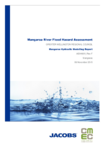Mangaroa River Flood Hazard Assessment
Search in document library
Purpose of the Report
To update the 2007 Mangaroa River flood model and improve flood hazard mapping using updated data and modelling techniques.
Geographic Area Covered
The Mangaroa River catchment in Upper Hutt, Wellington Region, New Zealand, including tributaries such as Black Creek and surrounding floodplain areas.
Summary of the Report
This report presents an updated hydraulic model of the Mangaroa River catchment, replacing the 2007 version. The update was prompted by peer review recommendations and incorporates improved data and modelling practices. Key enhancements include higher resolution bathymetry using 5 m grid LiDAR data, extended modelling of Black Creek, refined channel alignments, and updated rainfall-runoff modelling using the SCS unit hydrograph method. Climate change impacts were also included in the design rainfall estimates.
The model was calibrated using three major flood events and validated against additional historical data. While the model performed well for high-flow events, it tended to underestimate lower flows. Tailwater effects from the Hutt River were excluded from calibration by filtering events where Hutt flows exceeded 500 m³/s.
Design flood estimates for the 1% Annual Exceedance Probability (AEP) event with climate change ranged from 426 to 515 m³/s, aligning well with statistical flood frequency analyses. Sensitivity analyses were conducted to assess the impact of culvert blockages, increased roughness, hydrology changes, and downstream boundary effects. These were combined to produce worst-case hazard maps with an added 300 mm freeboard.
The report recommends adopting the 2014 model with balanced storm hydrographs for flood risk planning. It highlights significant differences in flood levels around Black Creek and the upper catchment compared to previous assessments. It also suggests considering a combined Mangaroa–Hutt River model for improved calibration near the confluence and installing a second gauging station unaffected by Hutt River tailwater.
Limitations include potential LiDAR errors in vegetated areas, limited validation for low-flow events, and uncertainty due to tailwater influence. The report advises periodic review and updates to the model as new data and methodologies become available.
